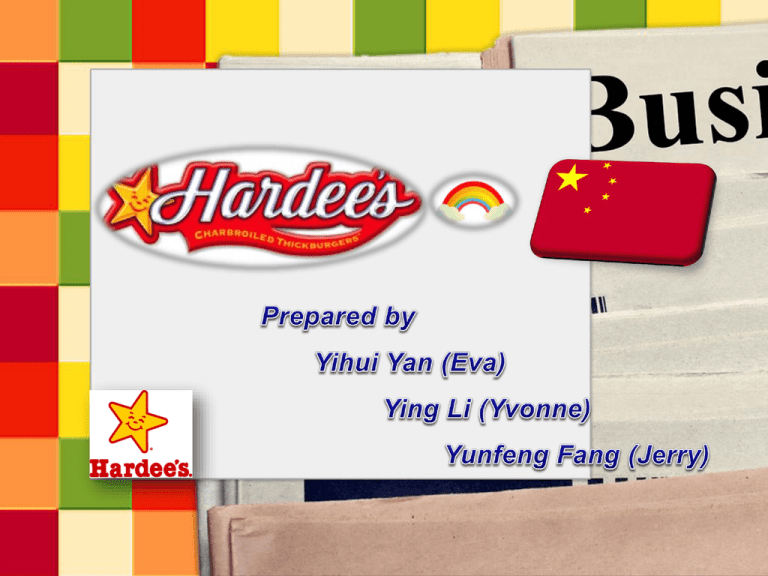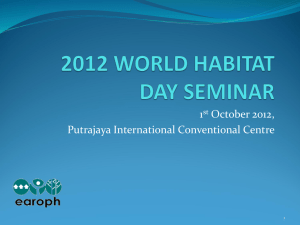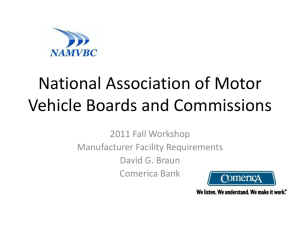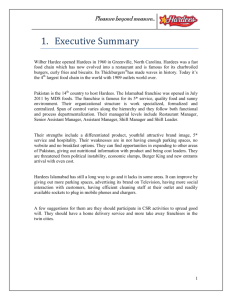PPT
advertisement

Fun Facts • Slogans of Hardee’s - Where the food’s the star. - Hardee’s. Come on home. • Unique Strategy compared with its competitors - Offer high-calorie fast food to appeal to those who care more about taste, less about their weight Ex: MONSTER Thickburger • Successful Children’s Advertising - Kids meal toys (Disney characters, Smurfs ……) 1990 Franchise History Founded by Wilber Hardee in Greenville, North Carolina in 1960 First franchise store in Rocky Mount, North Carolina in 1961 Went public in 1963 Purchased by Imasco in 1981 Wholly-owned by CKE Restaurant, Inc. in 2007 More than 1,900 stores in 30 U.S. states and 9 countries Ranked 16th in “Entrepreneur's Franchise 500®” in 2010 Franchise Market Assessment The fast-food market in China is developing favorably The local and foreign competitors are challenges for Hardee’s The low-cost of ingredients and labor in China are evidently profitable and available advantages Franchise Future Outlook in China Factors that ensure a promising future in China Higher purchasing power and less trade barriers Receptive attitude of Chinese people The high-quality and low-cost supply of raw materials On the whole, Hardee’s will expand from metropolises like Beijing, Shanghai, and Guangzhou to other cities Competitive Franchise zzzzzzzzzGlobal McDonald's • First store in zzzzzzzzz Local KFC • Establish its Malan Noodle • About 400 China: Shenzhen first store in stores in China, in 1990 Beijing in 1987 including 110 • About 1,100 • More than 3,000 stores in China stores in China up to 2010 in 2010 stores in Beijing and Tianjin Business Environment Analysis Report Demographics Large population: 1.4 billion (0.629%) - one fifth of the world’s total Urban population: 566 million - Beijing: More than 22 million residents Age Structure - Young generation (15-39) 41.32% With highest purchasing power High Population Density: 133 people per sq km 8.1% 30.78% 19.8% 41.32% Business Environment Analysis Report Government 1978 Deng Xiaoping - Market-oriented reforms and opening-up policy 2001 joined the WTO - Reduced barriers & Implemented favorable polices Commercial Franchising Regulation & Latest Tax Law - “ Foreign franchisors are now on an even playing field with local franchisors.” -- China CFR Currency: Yuan (RMB) - Possibility of RMB to replace the dollar as an international currency Business Environment Analysis Report Physical & Communication Infrastructure Efficient transportations 1.9 million km of highway 78,000 km railways 97 airports Internet users (CNNIC) - 420 million, 31.6% a well performed “cold chain” Business Environment Analysis Report Economics Second largest economy by GDP - $ 10.084 trillion at purchasing parity - GDP growth rate: 9.6% Consumer inflation rate: - 0.7% (2010) Increasing disposable incomes Ex: Shanghai: 28,838 Yuan Countries with Largest Economies in 2010 Business Environment Analysis Report Immense Labor Force 813.5 million Low cost of labor, material and land 1.62 18.65 Business Environment Analysis Report Culture Globalization More McDonald's & KFC Fit the fast-paced lifestyle More receptive to fast food A way of living, a part of life Competitive Nations Singapore Demographics Population: 4,987,600 Age structure: similar to China - Young generation with high purchasing power Urbanization completed in 2008 - 100% of its population is urban citizens A middle class society - Nearly 70% of the total population is middle class Competitive Nations Singapore Economy Highly developed market-based economy The total GDP at Purchasing Power Parity is $225.338 Inflation rate: 0.2% Low-risk country, ranked No.1 in ease of doing business rankings Economic freedom: Less red tape and bureaucracy Competitive Nations Singapore Culture Westernized life style Main language: English Various culinary cultures Shortcomings compared with China Smaller market size and lower growth rate The labor and land cost is much higher - The hourly compensation cost Singapore: $19.5, China: $1.36 Competitive Nations Malaysia Demographics: Population: 28.25 million Rapid urbanization: 65.1% of the total population Government Encourage and promote franchising More than 233 franchisors in Malaysia with 6,125 franchisees Competitive Nations Malaysia Economics: GDP: $403.042 billion at PPP in 2010 Relatively open state-oriented and newly industrialized market economy 3rd largest economy in South East Asia (2007) The boom of tourism industry leads the food industry prosperous alongside Competitive Nations Malaysia Food culture Preferences to local spicy food Shortcomings compared with China A relatively high inflation rate (0.4%), smaller market size and lower market growth rate Protectionism of the government Recommendations Short Term Offer low-price food with superior quality and service Launch effective promotional activities Provide healthier food Long Term Keep working on products and service innovation Implement both standardization and localization strategies Open more stores in various favorable locations Conclusion China Demographics 5 Singapore Malaysia 2 3 Government 3 4 2 Infrastructure 3 4 3 Economics 5 4 3 Culture 3 19 4 18 4 Total 15 China offers more favorable business environment for Hardee’s than Singapore and Malaysia.











